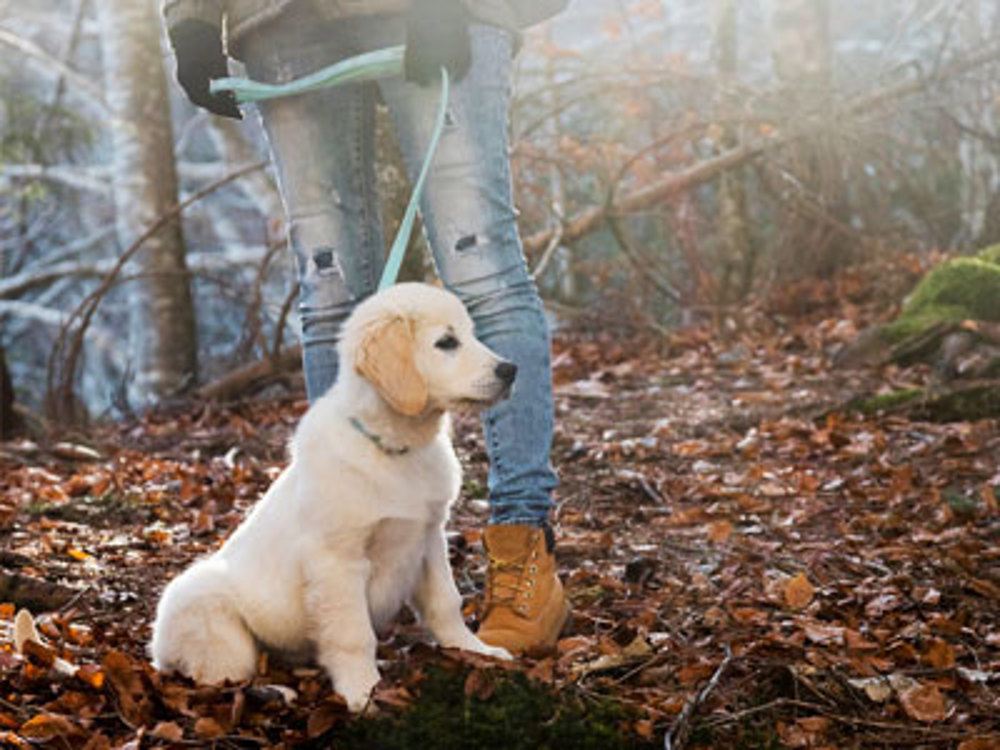
Lead training your puppy takes time and patience for both you and your puppy so do your best to avoid scolding them. It's not fair to correct puppies for something they don't understand.
Choosing the right collar
The secret to getting a good collar for your puppy is to buy one that fits them now but is also easy to adjust as puppies grow very quickly! Choose a small, lightweight one that's suitable for the size they are now. Don't get one you think they'll grow into eventually, because that's just going to be too big, heavy and intimidating.
You can buy one with clips on it to start with, just because it's going to be a lot easier to introduce it to them. You can just put it on and clip it together, rather than fiddling with buckles which can be scary when they're wearing a collar for the first time.
Introducing the collar to your dog
The first thing is to put on the collar and immediately after give them a treat, so that they realise that the collar means good stuff. Don't put the collar on, then take it off and give them a treat, otherwise all you're rewarding them for is having the collar off.
Put it on nice and quietly – and this is where you'll find the real advantage of the clips because you don't have to mess around with the buckles – and the minute the clip is on, give your puppy a treat.
Then you can build up the length of time that they're wearing the collar for, until they're wearing it for longer and longer periods of time. Be mindful about your puppy wearing a collar in the house. Keep an eye on them in case the collar gets caught on anything such as furniture, as this may hurt your puppy. However, also consider that a young puppy can be quick to escape and having a collar or harness on in the house may provide extra ability to secure your puppy if needed!
Introducing the lead to your dog
Once your puppy is happy wearing the collar, you can introduce the lead. Just start off in the house – don't try to go out and about straight away. You should think about the lead as a safety device so that they don't run off anywhere, not as a means to pull your dog around. You want a dog that doesn't pull on the lead, so you don't start by pulling first.
First of all, clip on the lead and give them a treat while you put it on if need be. The minute the lead is on, just use the treats (instead of pulling on the lead) to lure them beside you so that they get used to being on a lead without moving and then you can gradually increase this in stages by walking a few steps on the lead and with the collar attached.
As well as using treats, you can also make good use of toys – especially if your dog has a favourite one – to do exactly the same thing. Walk around the house with the lead on and lure them with the toy. That way your puppy will build a positive connection with wearing the collar and lead without making any fuss whatsoever.
The most important thing is to never pull on the lead. If it is ever tight, just lure your puppy beside you with a treat or a toy while walking, or if your puppy is ahead of you just turn around so your puppy is behind you and take a few steps in the other direction. All you're doing is getting them used to moving around beside you with the lead and collar on. Remember to keep your hand down (the one holding the treat or toy) so your puppy doesn't get into the habit of jumping up at you. This helps your puppy learn that they can move around with a collar and lead on and that the lead is never something that they're going to pull on. Gradually reduce the amount of treats your puppy is rewarded with so that they don’t just get used to following a food treat.
If you feel that your puppy is getting stressed when walking on a lead outside, walk to the end of the lead, crouch down and call them in for a treat, or go with a family member and have one of you walking ahead and calling the puppy for treats. You'll then be turning this into a rewarding game and showing your puppy that there are good times are ahead. That way your puppy will learn to focus on what's ahead of them with curiosity instead of fear.
Please note: there are many different ways to train your dog. This is just one method of teaching. If you are ever in doubt, please seek professional advice.
For more information and advice, you can find training classes with The Kennel Club Good Citizen Dog Training scheme, browse our full list of The Kennel Club Accredited Instructors or find a dog training club near you.
